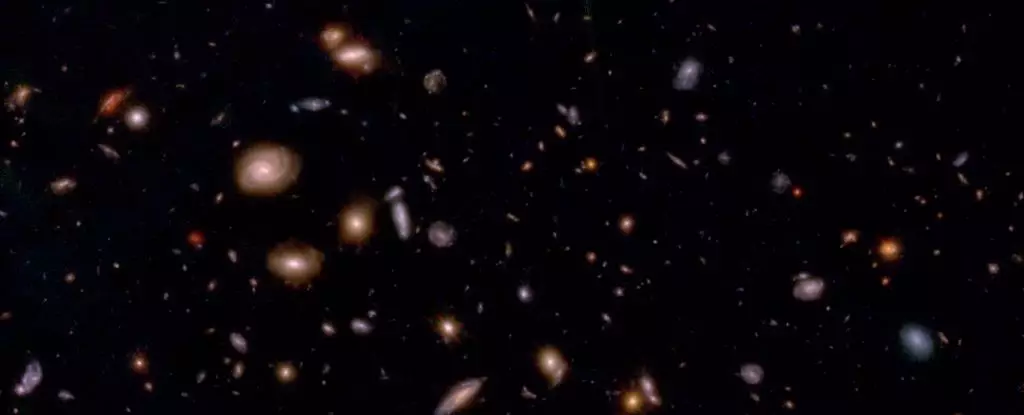In the grand tapestry of the cosmos, mysteries abound, beckoning humanity to probe deeper into the unknown. Recent observations suggest that the majority of galaxies in the Universe rotate in a surprising uniform direction, challenging long-held cosmological beliefs. This peculiar alignment presents not only an intriguing riddle for astronomers but also reflects a significant gap in our understanding of the Universe’s behavior. As scientists delve further into this enigma, they are left questioning the very nature of galactic formation and dynamics.
Current models propose that galaxies, influenced by an intricate web of dark matter, should exhibit a haphazard distribution in their rotational orientations. The expectation was that a diverse variety of spin directions would result in a 50/50 split between clockwise and counterclockwise rotations. Yet, the observations contradict this assumption, presenting a distinct asymmetry in the spin dynamics of galaxies. Lior Shamir, an astronomer from Kansas State University, highlights this unexpected trend, suggesting that it may stem from either the inherent properties of the early Universe or from the influence of our own galactic perspective.
Two Competing Theories
The potential explanations for the observed galactic rotation patterns can be summarized into two main theories. The more thrilling option posits that the Universe itself may have been born spinning, a notion that aligns with radical theories like black hole cosmology. If we indeed exist within the confined parameters of a black hole, then our understanding of space-time relics and cosmic origins becomes fundamentally flawed, necessitating a re-evaluation of cosmological theories that have stood the test of time.
Conversely, a less exciting explanation suggests that this apparent asymmetry could merely be an illusion caused by the rotation of our own galaxy, the Milky Way. The implications of either scenario are profound—the former nudging us towards a revolutionary shift in the framework of physics and the latter hinting at a significant oversight in our observational methodologies. As we cling to our familiar models of the Universe, the weight of these findings presses hard against the boundaries of our current understanding.
The Evidence from Cosmic Observations
The growing body of evidence supporting Shamir’s claims comes from meticulous research utilizing data from the James Webb Space Telescope (JWST) Advanced Deep Extragalactic Survey (JADES). By examining the rotational characteristics of 263 galaxies with light that has traversed the cosmos for approximately 5 to 10 billion years, Shamir unearthed a striking disparity: 158 galaxies exhibit clockwise rotation while only 105 show counterclockwise motion. This uneven distribution begs an explanation and raises questions about the isotropic nature of the Universe—the principle that it should look the same in all directions.
Shamir’s methodology involved a quantitative analysis of these galaxies based on their shapes. The stark evidence—easily discernible even to the untrained eye—adds substantial weight to the argument that our Universe is not as random as we once believed. Yet, these assertions demand rigorous scrutiny, for they challenge foundational concepts such as uniformity and isotropy, which have underpinned cosmological theories for decades.
Implications for Cosmology
Should further studies confirm Shamir’s findings, the implications could be earth-shattering. The very fabric of cosmological knowledge may require a restructuring, redefining our perceptions about the Universe’s expansion, its origins, and its peculiarities. If the sources of this galactic spin asymmetry are rooted in our observational standpoint—prime examples being the dynamics of our own Milky Way—then a recalibration of distance measures and velocities used in deep-space calculations would become necessary.
Moreover, this growing recognition of such a pronounced cosmic order could lead to enhanced understanding of dark matter’s role in galaxy formation and rotation patterns. Given that dark matter is believed to compose a significant portion of the Universe’s total mass, unraveling its properties could pivot our grasp on cosmic evolution.
A Call to Action for Astronomers
As the intrigue surrounding this galactic rotation mystery continues to unfold, it becomes imperative for astronomers and cosmologists alike to further investigate these abnormal spin patterns. In doing so, they may not only unlock the keys to this specific enigma but also enable a wider understanding of the cosmic narrative. The sky is not just a vast, untouched canvas; it is a history book—each galaxy a chapter, each rotation a sentence in the ongoing evolution of the Universe.
Humanity stands on the precipice of significant strides in cosmological research, armed with advanced observational tools like JWST. The prospect of uncovering groundbreaking insights into the fundamental laws governing our Universe stirs excitement within the scientific community. Now is the time for a concerted push to further probe these anomalies, decipher their implications, and reshape our understanding of the heavens above.


Leave a Reply